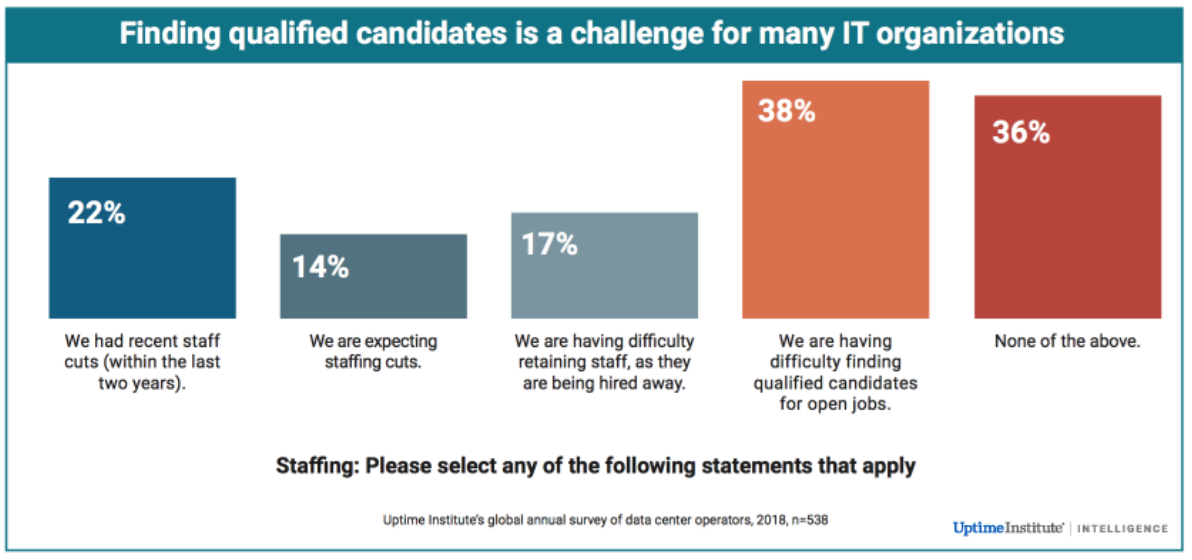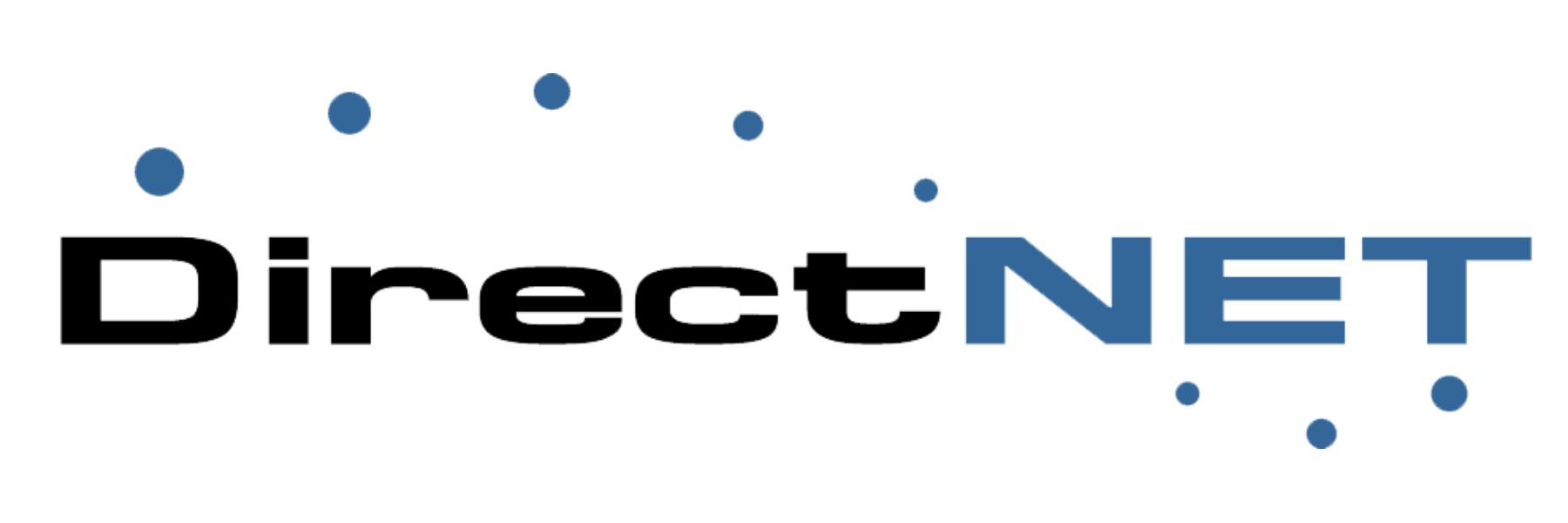Leveling Up Unskilled Workers in the Data Center

Data Centers are facing an age-old problem that we all eventually need to contend with; time. As the clock keeps ticking forward, we forget that it’s been some decades since servicing the online needs of the world was a revolutionary new idea that never seemed like it would slow down. The eager young workers who made this industry a bedrock of society are now experienced veterans and have earned their retirement. In fact, a Vertiv survey notes that 16% of their participants plan on retiring by 2025. This is coupled with an average estimate of 33% of the American workforce planning on retiring by 2025.
The Need to Consider Staffing in Data Centers Has Been Slowly Rising
The Uptime Institute put together the following graph from their 2018 Survey regarding Data Center staffing.

You can see that the primary issue is and continues to be finding qualified candidates.
The Need for New Workers in the Industry
There’s no need to approach the inevitable march of time with negativity. It’s essential to recognize that a significant amount of talent is leaving soon. Data centers need to bring in newer talent now so that veterans can impart skills and knowledge to the next generation.
Certain roles in the data center will always require a strong STEM related academic background. These roles will always benefit from essential knowledge that comes with experience, but the pool will be limited by those who have the proper schooling. However many roles may not require that kind of academic background. As the need to fill positions in the IT industry rise we will find that academic requirements might need to be reconsidered.
Why Data Center Hiring Practices Will Get More Complicated
Right now, the average expected skillset for a data center worker is beyond those of the average American worker, as detailed by Zippia. Even entry-level positions have requirements that expect knowledge, expertise, or certifications that would be impossible for a lower-level worker to obtain.
Recently we’ve heard the news that more STEM college graduates are coming, which is excellent. However, even these workers will be inexperienced despite their technical aptitude. Institutional knowledge needs to be transferred to this new wave of workers. Meaning even this growth in STEM graduates in the job pool alone won’t address the growing need for more qualified Data Center workers.
Planning for Acquiring Unskilled Labor
Workers are often caught in a Catch-22 when looking for new work. They are usually required to have some industry or technical experience that can only be gained through work in the industry before they’ve been allowed to set foot in the industry. Some seek education on their own to become more skilled, taking online courses, or short classes to bridge the skill gap.
Those considering a career in Data Centers don’t have this option, however. It would be impossibly expensive to afford the equipment to practice with at home. Classes for Data Centers are equally costly. A course from ConnectedPNG would cost $5,200, for two days of education, and assumes that those attending are familiar with Data Centers already, as it’s intended as a boot camp for those already in the profession.
How Can Data Centers Level Up Unskilled Workers?
Lage Data Centers can reconsider how they come by new talent. Instead of expecting everyone applying to an entry-level position to already have the skills and experience necessary to work in a data center, the hiring gap can be bridged by bringing in motivated individuals to a journeyman like program. This will create a path for longevity that addresses many worries that come with hiring raw talent.
While younger workers are known for jumping from job to job seeking a raise, offering a journeyman role reframes expectations from the start. Working towards a future within an industry, coupled with relative job security, gives workers a salient reason to stay in their role. Employees will want to stay loyal to a company that helped them out when they were coming up and continues to foster their growth as a worker with meaningful advancements as the years continue.
Those who staff data centers should consider more rigorous hiring practices when considering this raw talent. The data from the Pew Research Center has shown us opportunities that are being overlooked in America. Some of these are more widely known, such as racial and gendered pay gaps, that can be overcome by paying everyone fairly. Advancement in pay can even be considered in advance while formulating a journeyman program. A strong show of diversity and employee development allows an organization to stand out as a community and industry leader.
The educational pay gap is hurting those who didn’t finish or attend college more so than ever before. Offering younger workers a role that comes with built-in education and the promise of longevity would produce loyalty and motivation rarely found in the job market. These workers can start with menial tasks and entry training at very competitive rates compared to other workers, and quickly scale to take on more technical tasks.
How to Go About Leveling Up Workers
Schneider Electric has done a great deal with employee advancement in recent years. They have even moved past the journeyman path, and see a more sophisticated solution integrating education and role advancement that is starting to bear results.
They attract newer workers with the promise of experience with exciting technologies like 3D modeling and lasers. From the onset, they have a clear career path, showing a sign of development and longevity that makes their positions more attractive than a dead-end job – even if the job pays a little less to start. This career pathway shares the same benefits and appeal as a journeyman program.
What sets Schneider Electric apart is a set of internal education courses that provide workers with the education they need to move forward with their careers. These courses cover ways to move into new positions. They also ensure that their employees stay up to date with technological advances that can save time and effort. Schneider believes that newer generations are absorbing information more quickly than past generations aiding in this growth model.
Some places need to make more immediate solutions. Simply ensuring you are bringing new talent to learn directly from experienced workers is a great place to start. In short order, you’ll have redundancy for when workers take the day off, allowing data centers to remain running with less planning and frustration overall. Like anything else in the Data Center, redundancy is essential.
Keeping the New Talent in the Company
 When coming in fresh to the data center, newer workers often expect the equipment to be performing well within standards, and are usually surprised when things are underperforming or using legacy systems.
When coming in fresh to the data center, newer workers often expect the equipment to be performing well within standards, and are usually surprised when things are underperforming or using legacy systems.
Every data center is different, but if older tech is holding the data center back, it can send an implicit message that this component or system is a ticking time bomb that will quickly become the new hire’s problem. Who wouldn’t start thinking about removing themself from that situation? Ensuring everything is working properly will raise confidence and help demonstrate the same longevity within the data center that you’d hope to see from an employee.
This Clutch survey indicates workers consider new technology in the workplace as an opportunity. It can give them a chance to learn a system at the same time their co-workers are. We’d presume that this mindset of the worker seeing new technology in the workplace as an opportunity, would also have the mindset required to learn about the tools and practices of the data center quickly.
It can be worth waiting to purchase new technology until the new talent is hired, creating a more comprehensive data center refresh. Having the new workers handle the mundane task of inserting a new dongle, switch, or KVM across the various racks will help them learn while building familiarity right from the start of their employment.
Other Solutions to Keep Knowledge in the Data Center
Keeping tribal knowledge within the company can require more creative solutions. Some data centers keep old employees on tap as consultants. Some help the worker move to a new position within the company but encourage them to help their former departments when necessary.
Creating an internal library allows employees to access technical histories of their equipment, read about solutions to problems that have arisen in the past, and document other oddities that they wish they could have simply found in reference.
Once documented, this internal knowledge base can turn every difficulty, discovery, and process enhancement from ethereal into a tangible, self-service library and real time saver. Access to a library such as this should enable a newer employee to level themselves up though their employment and kick start their onboarding process. This will also keep tribal knowledge accessible to the company even after employees move on. If anyone should be using data to its fullest potential, it should be the data center industry.
This library will need to be organized in a uniform way so that anyone can navigate through the information quickly. It will also need to be updated regularly. Best practices would include an annual audit to keep everything relevant.
Are You Convinced to Start Leveling Up Your Workers?
Hopefully, you’re convinced at this point that Data Centers need to consider their talent pool and make sure that they are always thinking about the next generation. While practices and technologies keep progressing and changing rapidly, the need for quality workers never goes away. As the adage goes: the best time to consider this was five years ago, the second-best time is now.




